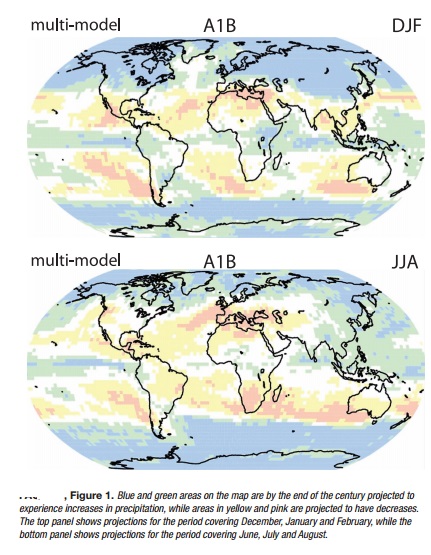Chapter: social science geography student essay
Do Projected Changes in Climate Vary from Region to Region?

Do Projected Changes in Climate Vary from Region to Region?
Climate varies from region to region. This variation is
driven by the uneven distribution of solar heating, the individual responses of
the atmosphere, oceans and land surface, the interactions between these, and
the physical characteristics of the regions. The perturbations of the
atmospheric constituents that lead to global changes affect certain aspects of
these complex interactions. Some human-induced factors that affect climate
('forcings') are global in nature, while others differ from one region to another.
For example, carbon dioxide, which causes warming, is distributed evenly around
the globe, regardless of where the emissions originate, whereas sulphate
aerosols (small particles) that offset some of the warming tend to be regional
in their distribution. Furthermore, the response to forcings is partly governed
by feedback processes that may operate in different regions from those in which
the forcing is greatest. Thus, the projected changes in climate will also vary
from region to region.
Latitude is a good starting point for considering how changes
in climate will affect a region. For example, while warming is expected
everywhere on Earth, the amount of projected warming generally increases from
the tropics to the poles in the Northern Hemisphere. Precipitation is more
complex, but also has some latitudedependent features. At latitudes adjacent to
the polar regions, precipitation is projected to increase, while decreases are
projected in many regions adjacent to the tropics (see Figure 1). Increases in
tropical precipitation are projected during rainy seasons (e.g., monsoons), and
over the tropical Pacific in particular.
Location with respect to oceans and mountain ranges is also
an important factor. Generally, the interiors of continents are projected to
warm more than the coastal areas. Precipitation responses are especially
sensitive not only to the continental geometry, but to the shape of nearby
mountain ranges and wind flow direction. Monsoons, extratropical cyclones and
hurricanes/ typhoons are all influenced in different ways by these
region-specific features.
Some of the most difficult aspects of understanding and
projecting changes in regional climate relate to possible changes in the
circulation of the atmosphere and oceans, and their patterns of variability.
Although general statements covering a variety of regions with qualitatively
similar climates can be made in some cases, nearly every region is
idiosyncratic in some ways. This is true whether it is the coastal zones
surrounding the subtropical Mediterranean Sea, the extreme weather in the North
American interior that depends on moisture transport from the Gulf of Mexico,
or the interactions between vegetation distribution, oceanic temperatures and
atmospheric circulation that help control the southern limit of the Sahara
Desert.
While developing an understanding of the correct balance of
global and regional factors remains a challenge, the understanding of these
factors is steadily growing, increasing our confidence in regional projections.
Related Topics